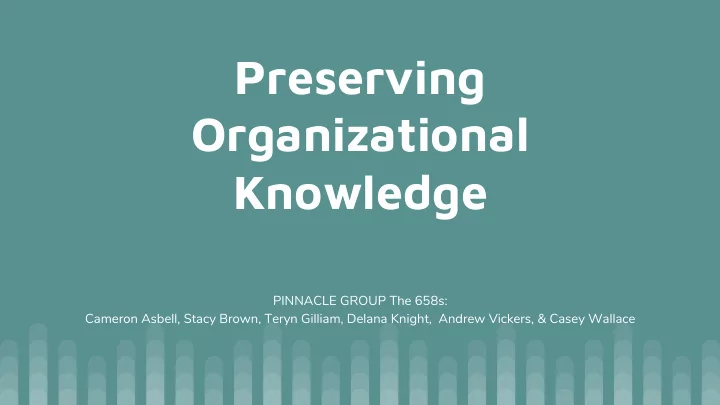

Preserving Organizational Knowledge PINNACLE GROUP The 658s: Cameron Asbell, Stacy Brown, Teryn Gilliam, Delana Knight, Andrew Vickers, & Casey Wallace
Introduction “Losing experienced staff causes gaps that can negatively affect library service, especially when the employee leaving is taking a substantial amount of work, business, and operational knowledge that is difficult to replace or duplicate.” 1 Andrew M. Pena “Institutional Knowledge.” University Business Magazine, December 5, 2014
Current Condition of the Problem As found in: Professional Literature ● A Recent Survey ● Case Studies ● 2
Case Studies Anonymous Interviews with Public Library Directors Case Study #1: IT Specialist unexpectedly resigns ● Case Study #2: Branch Manager passes away ● Case Study #3: Finance Manager quits ● 3
Case Studies Case Studies reinforce many themes in research literature: Lack of preparation for succession ● Need for a strategic plan ● Need for sharing institutional ● knowledge Cross-training ○ 4 Documentation ○
What the Literature Says: Internal Challenges General unpreparedness for succession ● lack of organized information ○ no regular preparation habits ○ Underestimating the time needed to prepare ● years, not months ○ 5 Conflict in deciding to look within or outside for ● replacement candidates
Internal Challenges (continued) Should you expand definitions of ● qualifying skillsets? being bilingual ○ promoting non-MLS degree holders ○ Emotional tensions surrounding a ● leader/expert’s decision to step down Encouraging an existing expert to ● 6 participate in a constructive transition
External Challenges Smaller pools of replacement candidates ● compared to the number of retirements Shortages of specific skills and experience ● Increased demands for training on basic ● library skills Working with the limitations of workers who ● are in a “second” career or may only be interested in part time-work 7
Survey Results 84 respondents from Academic and Public Library Administration
Survey Results Do you have a plan to replace key positions? 48% No 23% Yes 19% Are working on a plan
Survey Results How long would it take for you to replace a key member of workforce? 37% predict 1 - 2 months 26% predict 3 - 4 months 18% predict 5 - 6 months 14% predict 6 months -1 year
Survey Results How do you feel that your library manages Succession Planning? 30% rate themselves as planning Poorly 26% rate themselves as Neutral in planning 21% rate themselves as planning Well 19% rate themselves as having a Fair plan 3.6% rate themselves as planning Extremely Well
Survey Results What core competencies are most important when selecting an internal or external candidate for a key position?
How to Establish a Succession Plan: Our Strategy to Close the Gap 1. Identify Critical Positions 2. Forecast Future Vacancies 3. Identify Potential Employees 4. Transfer of Knowledge 5. Reconsider Your Team Configuration 6. Know Your Team’s Interests and Needs 7. Support For The Successor 8
How to Establish a Succession Plan 1. Identify Critical Positions Director Technical Services Manager Payroll Clerk 9 10 11
How to Establish a Succession Plan 2. Forecast Future Vacancies Planned Retirements ● Extended FMLA ● Military Leave ● Potential Turnovers ● 12
How to Establish a Succession Plan 3. Identify Potential Employees Conduct an Internal Search ● Run External Searches Concurrently with Internal Searches ● Hire Interns ● Interim Positions ● Loaner Staff ● 13
How to Establish a Succession Plan 4. Transfer of Knowledge Shadowing ● Mentoring ● Cross-Training ● 14 Written Procedures ● Leadership Development Training ●
How to Establish a Succession Plan 5. Reconsider Your Team Configuration Operate at a level of overcapacity. ● Hire two part-time employees instead of one full-time employee. 15
How to Establish a Succession Plan 6. Know Your Team’s Interests and Needs Tired of Their Job ● Is Not Engaged ● Has Upcoming Life Changes ● Has a Desire for Promotion ● 16
How to Establish a Succession Plan 7. Support For The Successor A Good Team ● Mentors ● Coaching ● Feedback ● 17
Conclusion How do we know we have been successful? Photo attribution: Flickr users Daniel Pietzsch (1 & 18), Walfer (2), Evan Long (3), Gabriel Sai (4), Burns Library, Boston College (5), Bill Alldredge (6), Vincent F (7), Jordanhill School D&T Dept (8), icannphotos (9), San Jose Public Library (10), (11), Rob Bixby (12), Peter (13), Bully Whippit (14), velacreations (15), Thomas Hawk (16), La_Shy (17) 18
Questions? Cameron Asbell , Ohoopee Regional Library Stacy Brown , Conyers-Rockdale Library System Teryn Gilliam , Atlanta- Fulton Public Library System Delana Knight , Northeast Georgia Regional Library System Andrew Vickers , Mountain Regional Library System Casey Wallace , Gwinnett County Public Library
Recommend
More recommend